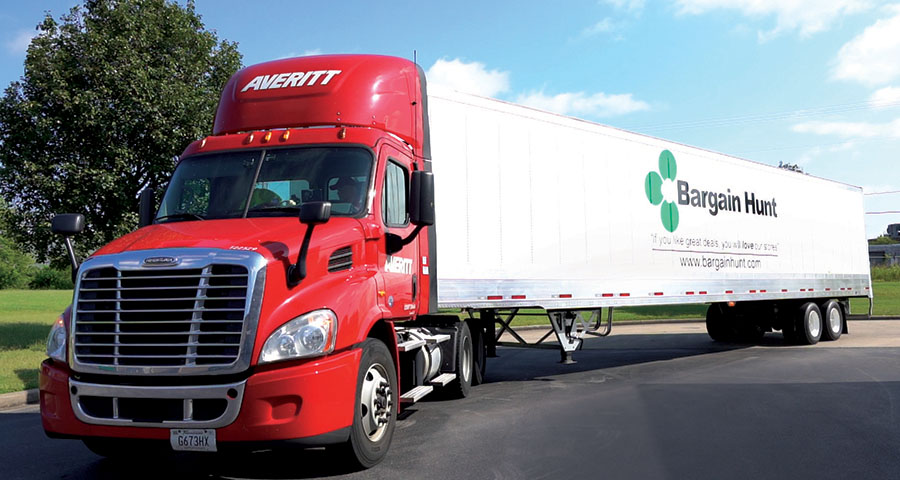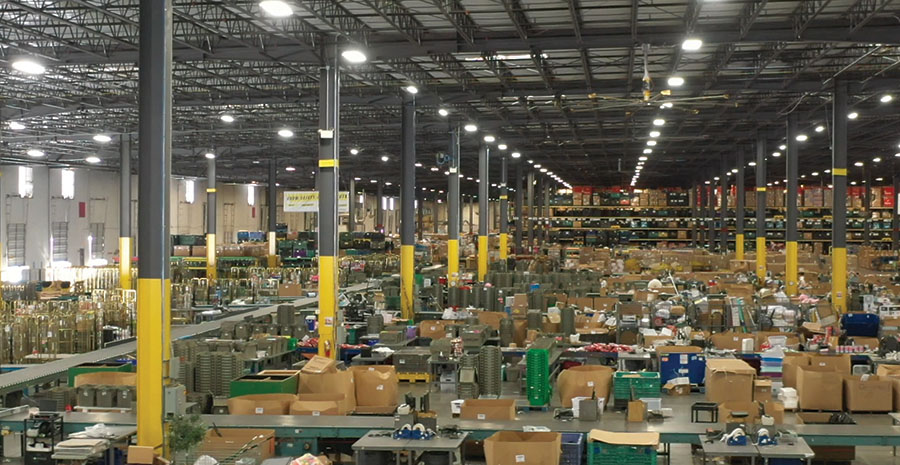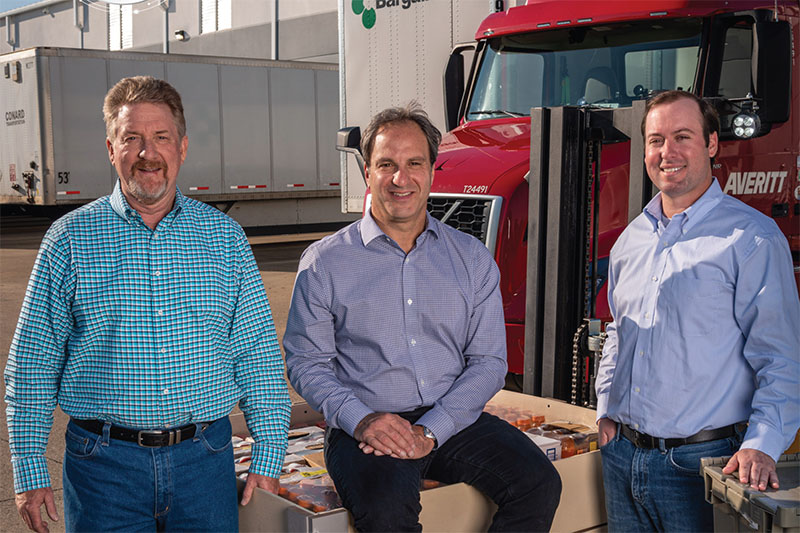Alliance Award Winner: Bargain Hunt partners for growth
Through a unique trucking partnership, the extreme discount retailer has streamlined its process, integrated new technology and cut the size of its fleet in half while serving more locations than ever—all while reducing the number of miles driven by 20%.
 Steady growth is good for business. But with it comes challenges—primarily the need to maintain smooth and efficient operations on an ever-expanding scale. For Bargain Hunt, a Tennessee-based extreme discount retailer, accommodating that growth required making some key changes to its long-standing supply chain approach.
Steady growth is good for business. But with it comes challenges—primarily the need to maintain smooth and efficient operations on an ever-expanding scale. For Bargain Hunt, a Tennessee-based extreme discount retailer, accommodating that growth required making some key changes to its long-standing supply chain approach.
With 90 store locations throughout the Southeastern United States and more on the way, the company knew that in order to make its goal of profitable expansion a reality, they needed a supply chain partner who could help build on the successful changes that were already underway internally.
After opening its first store in Nashville in 2004, Bargain Hunt grew steadily for more than a decade—all while utilizing the same dedicated supply solution it had since the beginning. But after being purchased by a private equity firm in 2015, the company’s rate of growth accelerated dramatically with the addition of 40 stores soon after the acquisition.
With the arrival of a new leadership team in 2017, the company kicked off a two-year plan to transform the supply chain. This plan had four objectives: reduce costs across the value chain; deploy best practices; provide a supply chain platform that could scale while being a strategic differentiator; and act in service to the stores.
The process began internally, with a change in how they handled their delivery containers and processes. And in the end, the result of this transformation and the ensuing partnerships it formed along the way earned Bargain Hunt one of three 2020 Alliance Awards presented by SMC3 and Logistics Management magazine.
The Alliance Awards are the only honor in the industry that recognizes strategic partnerships working to produce meaningful, collaborative supply chain outcomes. Here’s how Bargain Hunt leveraged its new partnerships and technology to achieve significant gains in efficiency along the way to substantial growth.

The companies developed a relay model that leverages Averitt’s network of service centers to maximize efficiencies.
Getting new goods at great value
As a discount retailer, Bargain Hunt purchases two types of merchandise for their stores: traditional closeouts and reverse logistics. But its manner of distributing those products was inefficient.
“When I arrived in 2017, we were shipping all categories in a common container,” says Steve Silverman, the company’s senior vice president of supply chain. “We would fill the trucks, drop the trailer at the back door, and tell the store to unload and sort the merchandise. It could take them more than 60 man hours to get merchandise to the shelf, when it should take a quarter of that time.”
Because one of the key consumer drivers in extreme discount retailing is “freshness”—getting new goods at great value on a regular basis—the first job for Bargain Hunt was to change its container approach.
“The first thing we did was deploy a multi-faceted delivery container solution that was completely ‘roll off at the store,’” says Silverman. “We also started sorting the merchandise by categories, packing smaller items in totes, using roll-tainers for larger items, and developing a custom-designed rolling cart for hanging apparel.”
As a result, when the truck arrived at the store, all the team had to do was roll the containers to the proper shelf area based on category. “But that only got us part of the way there,” says Silverman. “The next step was to look at the dedicated fleet solution.”
The company’s retail distribution playbook had worked when the store count was small and closer to Nashville. “Then we had all of our assets, from drivers to power units, based at our distribution center in Antioch, Tenn., which is just outside Nashville,” continues Silverman. “The contracted rate structure included leased equipment and mileage, plus fuel surcharge fees. As we expanded stores and increased shipment volume, it wasn’t scalable or economical. It only allowed for drop-and-hook delivery, which not only required additional trailers, but also took store personnel away from their primary duties of merchandising and taking care of our customers.”
And as the store base expanded into areas like Atlanta, Cincinnati, and the Carolinas—all served from the sole distribution center in Antioch—the problems mounted.
“With 26 tractors and 270 trailers, the asset utilization on our tractors dropped to roughly 10 hours a day,” says Silverman. “We couldn’t service our inbound backhauls, and our trailer cube capacity utilization was between 50% and 60%. The situation made zero sense, financially. We didn’t have the flexibility to move up and down based on seasonal volume. At peak, we needed to go to third-party carriers to help handle our shipments. And when you do that, you’re sacrificing the service you give your stores.”
With all of the company’s assets—including tractors and drivers—based near Nashville, drivers had to sleep overnight on the road. “We needed a solution that allowed our drivers to be home every day—that’s a must in a tight driver market,” says Silverman. What’s more, the back office was manually managed on spreadsheets without a standard delivery schedule to the stores, which meant there was no visibility and no electronic invoicing.
Straightforward and effective
So, the search began for a transportation partner that could help the company streamline its process and integrate new technology—all while accelerating growth.
“We conducted an extensive search process,” says Silverman. “But in the end, there were a number of factors that pointed us to Averitt Express. They’re customer-centric and built from the drivers up, so they know how to get freight on and off a truck efficiently. And when we started lining up their relay LTL terminals with our stores, they lined up very well.”
Added to this was the fact that, beyond Averitt’s LTL capability, they also have a dedicated linehaul group. “We wanted the best of both worlds with one provider,” adds Silverman.
So, together the companies developed a relay model that leverages Averitt’s network of service centers to maximize efficiencies. In early 2019, they launched a staged rollout of this new model starting with a relay terminal in Cincinnati then expanding to two additional terminals in Georgia.
“It took about three months for these terminals to become fully operational while we worked out the kinks—mostly things like systems integration, tendering process and backhaul coordination,” Silverman says. “Once the wrinkles were ironed out, we opened the other four terminals in June.”
According to Silverman, the new process is straightforward and effective. “All the drivers and tractors are based at seven relay points,” he explains. “The Averitt dedicated team leaves its terminals and drives linehaul through the night to the Antioch distribution center. Next, it exchanges trailers and returns to the originating terminal yard by 6 a.m.”
Some terminals are close enough to make two turns a night with the same tractor, and once back at the terminal the LTL team takes over. “They make all the local deliveries to the stores, bring the assets back, pick up a backhaul, and do whatever needs to be done in the market for the 11 hours they drive that tractor,” says Silverman. “Then, at night the dedicated driver gets back in and goes to the Antioch DC.”

The carrier’s dedicated team leaves its terminals and drives linehaul through the night to Bargain Hunt’s Antioch distribution center
(pictured above). Next, it exchanges trailers and returns to the originating terminal yard by 6 a.m.
From manual to integrated TMS
The new system also corrects the company’s former reliance on manually entering data into spreadsheets. Thanks to an integrated TMS, Bargain Hunt now enjoys full visibility and real-time exchange of data—complete with up-to-the-minute tracking updates.
This TMS is integrated with Averitt’s back office and coupled with a proprietary tendering system that monitors every stage of the process. “So now every leg of the journey is billed off, or accounted for, in the accounting system,” says Silverman.
The benefits have been substantial. Through the new relay model, Bargain Hunt has been able to effectively cut the size of their fleet in half while serving more locations than ever. The company has gone from 26 tractors to 16 and reduced their total trailers from 270 to 130—all while reducing the number of miles driven by 20%. Additionally, it can reach every store within 24 hours with fresh merchandise, if needed.
According to Silverman, with Averitt’s ability to off-load decked trucks at the stores, Bargain Hunt is now using between 80% to 90% of cube capacity—up from 50% to 60% in their previous model. And because the contract is mileage-based instead of asset lease-based, the model is easily scalable up and down, depending on volume. Perhaps most impressively, its tractor utilization has more than doubled—up to 22 hours a day over their earlier 10.
“What matters most is that we’re getting better service to our stores,” says Silverman. “With multiple relay points, Averitt is performing at more than 98.5% on-time and hitting a two-hour delivery window. Stores can better plan their labor needs because they know when their truck is coming. We only deliver to stores Sunday through Thursday, which gives them the time and resources to get the store properly prepared for weekend traffic.”
Silverman also has high praise for those making the deliveries. “The Averitt drivers have been fantastic,” he says. “They completely handle the unload, organize the freight in the back room, and load the return assets and recyclables—then they’re out of the way in 90 minutes. This keeps our staff on the floor taking care of our customers. And thanks to the relay model, we’re also able to pick up roughly 86% of the eligible backhauls in our geography.”
Another important benefit: Greater driver satisfaction, which leads to greater driver retention and better service at its stores. “Our new approach is helping to keep drivers fresh,” says Silverman. “They sleep in their own bed at night and are home every day, and that’s a big selling point in a market where qualified drivers are at a premium.”
Moving forward, Silverman sees more exciting changes on the horizon—including the possibility of using Averitt’s network of service centers to house Bargain Hunt’s breakbulk operations for larger items like furniture or appliances. “With Averitt and our relay solution, the sky’s the limit,” he adds. “We can continue to add stores in the geography without issue.”

Article Topics
Motor Freight News & Resources
XPO opens up three new services acquired through auction of Yellow’s properties and assets FTR’s Trucking Conditions Index weakens, due to fuel price gains TD Cowen/AFS Freight presents mixed readings for parcel, LTL, and truckload revenues and rates Preliminary March North America Class 8 net orders see declines National diesel average heads down for first time in three weeks, reports EIA Trucking industry balks at new Biden administration rule on electric trucks: ‘Entirely unachievable’ New Breakthrough ‘State of Transportation’ report cites various challenges for shippers and carriers in 2024 More Motor FreightLatest in Logistics
Under-21 driver pilot program a bust with fleets as FMCSA seeks changes Diesel back over $4 a gallon; Mideast tensions, other worries cited Four U.S. railroads file challenges against FRA’s two-person crew mandate, says report XPO opens up three new services acquired through auction of Yellow’s properties and assets FTR’s Trucking Conditions Index weakens, due to fuel price gains U.S. rail carload and intermodal volumes are mixed, for week ending April 6, reports AAR LM Podcast Series: Examining the freight railroad and intermodal markets with Tony Hatch More LogisticsAbout the Author
Subscribe to Logistics Management Magazine

Find out what the world's most innovative companies are doing to improve productivity in their plants and distribution centers.
Start your FREE subscription today.
April 2023 Logistics Management

Latest Resources
















